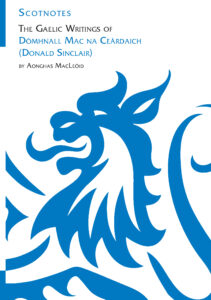‘what would happen if someone really scrieved in thir ane langwij / didn’t turn on their mouth lit it wis a loch tae be drained.’
It’s time once more to highlight new Scots and Gaelic book releases for 2025. If you missed the Spring 2025 round up, you can read that here. Here are some excellent books from the second half of the year.
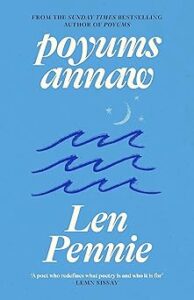 Poyums Annaw
Poyums Annaw
By Len Pennie
The follow-up collection to her bestselling Poyums, this collection is just as fiery, honest and expressive as her debut. With poems on social justice, feminism, relationships and perseverance, it’s perfect reading for those looking for inspiration and ideas on living today.
 Square Baw
Square Baw
By Hamish MacDonald
A beautiful, nostalgic and robust collection of poetry on football and what it means for family, community and history. Hamish MacDonald gives a starring role in this collection to his grandfather who played at junior and amateur level and fought in the First World War.
 Am Measg Luaithrean, Beò
Am Measg Luaithrean, Beò
By Robbie MacLeòid
Robbie MacLeòid’s debut pamphlet is about transgression and rebellion in many forms. The bilingual poems are provocative and exciting, and break form and language to interrogate Scotland, sensuality, and sin.
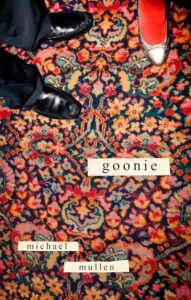 Goonie
Goonie
By Michael Mullen
Goonie is the raw and joyful debut collection from award-winning Scottish poet and spoken word artist Michael Mullen. It combines the oral tradition of Scots with whip-sharp Glaswegian humour to bring alive in language and form the full spectrum of human connection, from family parties to city living, to a chat with a hairdresser, to abiding friendship and queer awakenings.
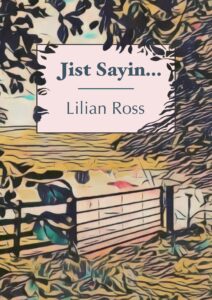 Jist Sayin’
Jist Sayin’
By Lilian Ross
A lovely collection of short stories, poems, and prose based on the author’s own memories and observations of the folk and culture of Aberdeenshire, marrying autobiography and imagination illuminated with humour and intimate nostalgia.
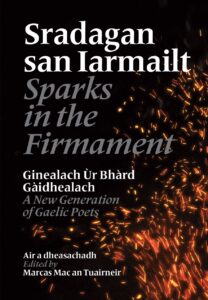 Sradagan san Iarmailt
Sradagan san Iarmailt
Edited by Marcas Mac an Tuairneir
This anthology showcases the talents of Gaelic poets who have come to prominence since the turn of the millennium. The poems cover a diverse range of subjects including social concerns, identity, cultural exchange, love, land and language.
The Gaelic Writings of Donald Sinclair
Edited by Aonghas MacLeòid
Dòmhnall Mac na Ceàrdaich (Donald Sinclair, 1885–1932) is a crucial writer in the development of Gaelic literature in the early twentieth century. This study guide covers a range of issues and concerns in his work, including Scottish Nationalism, the Celtic Revival, land reform, migration, and religion.
 Bho Pheairt Gu Hiort
Bho Pheairt Gu Hiort
By Iain Taylor
This is a Gaelic deep-dive into place-names and explains all the most common elements that appear in place-names accross Scotland. By the end of the book, readers will be able to piece together the meaning behind place-names across the country.
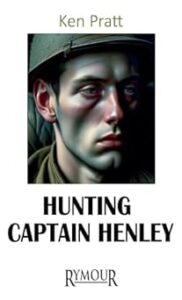 Hunting Captain Henley
Hunting Captain Henley
By Ken Pratt
Young Billy Queen is angry. He’s going to find the English officer who bullied his dad in the army and probably kill him. This bold, powerful novel tracks the progress of a tormented boy who turns into a subversive man hell-bent on vengeance.
 Soraidh Slan le Hallaig
Soraidh Slan le Hallaig
By Myles Campbell
Hallaig, Raasay, 1853. There are rumours that the people are going to be evicted by the landlord, Seòras Rainy, who keeps a tight rein on them with unreasonable rules, including a ban on marriage. This Gaelic historical novel explores power, love and the fight between tradition and change.
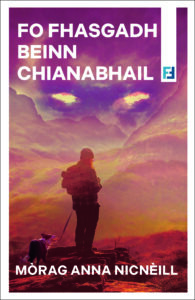 Fo Fhasgadh Beinn Chianabhail
Fo Fhasgadh Beinn Chianabhail
By Mòrag Anna NicNèill
When Kenneth returns to the island after being away for years, he plans to make a good life for himself in his old house. But he soon realizes that things are not going to be as easy as he had hoped. This psychological, gothic thriller asks questions on home, madness, and the supernatural.
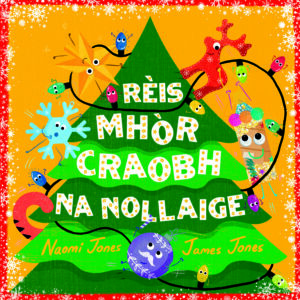 Rèis Mhòr Craobh na Nollaig
Rèis Mhòr Craobh na Nollaig
By Naomi Jones; illustrated by James Jones
A jolly Christmas story that sees three shiny friends race to be the star on top of the three. This picture book is geared towards children aged 3 – 7 years old.
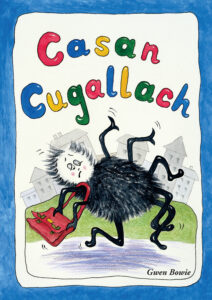 Casan Cugallach
Casan Cugallach
By Gwen Bowie
Introduce yourself to the trials of Donaidh, the wobbly legged spider! This picture book is suitable for readers aged 3 – 7.
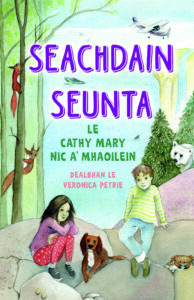 Seachdain Seunta
Seachdain Seunta
By Cathy Mary Nic a’ Mhaoilein
At the start of the summer holidays, Eilidh is disappointed that all the girls have gone on holiday to interesting places. Then she meets Patrick and they, along with Eilidh’s dog Peasan, end up going on a time travelling adventure! For readers aged 8 – 12.
 An Stàball
An Stàball
By Anne Ramsay
A gorgeous board book for babies and toddlers that will teach Gaelic words on animals.
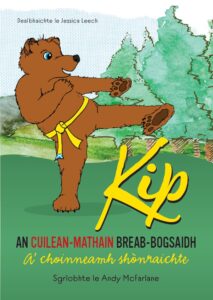 Kip an Cuilean-mathain Bhreab-bhogsaidh
Kip an Cuilean-mathain Bhreab-bhogsaidh
By Andy McFarlane
Kip is a Scottish bear cub. He practices martial arts and lives by the guiding principles of Taekwondo: Courtesy, Integrity, Perseverance, Self-Control, and Indomitable Spirit. This is a heartwarming picture book for readers aged 5 – 8, that addresses themes of inclusivity and resilience.
 Jocky Gentoo: The Adventures of a Penguin in Scots
Jocky Gentoo: The Adventures of a Penguin in Scots
By Julia Donaldson; illustrated by Axel Scheffler; translated into Scots by James Robertson
Are ye aw set for a pole-tae-pole adventure? Jocky, a gallus wee gentoo penguin, is awa for the jaunt o a lifetime. But shairly he’ll no can hoddle aw the wey tae Antarctica? Ideal for readers aged 3 – 6 years old.
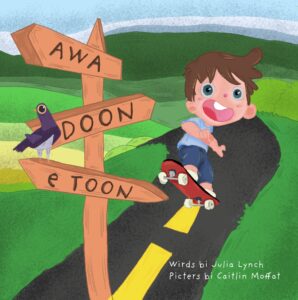 Awa Doon e Toon
Awa Doon e Toon
By Julia Lynch; illustrated by Caitlin Moffat
In Awa Doon e Toon, we follow one boy as he travels into town but is thwarted by the unpredictable Scottish weather! This is a great introduction to Doric Scots for readers aged 3 – 6 years old.
 Anesu agus na Creutairean Uisge
Anesu agus na Creutairean Uisge
By Tawana Maramba; illustrated by Ann Macleod
Anesu is nervous about starting her first day in a new school. Join her and her classmates as they share stories of mythical creatures from across the world, bringing them closer together. For readers aged 5 – 10.





